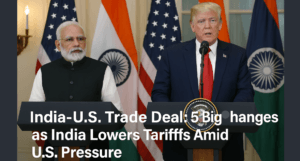India-U.S. Trade Deal: 5 Big Changes as India Lowers Tariffs Amid U.S. Pressure
India and the U.S. have finalized the framework for a new bilateral trade agreement (BTA) following intervention from the Prime Minister’s Office (PMO). With U.S. tariffs set to take effect on April 2, India has agreed to lower some tariffs on American goods in exchange for trade concessions. President Donald Trump hinted that India is making significant reductions, potentially easing tensions. Meanwhile, the U.S. Trade Representative (USTR) flagged concerns over India’s trade policies, including restrictions on agricultural imports, genetically modified (GM) foods, and high tariffs on key products.
The report also criticized India’s intellectual property framework, pointing to long patent approval times and weak trade secret protections. U.S. officials are particularly focused on India’s price caps on medical devices and data localization rules, which they argue hurt American businesses. Experts warn that while India must engage in trade talks, it should prioritize national interests, including economic growth and food security. The upcoming negotiations will be crucial in shaping the future of India-U.S. trade relations.

India-U.S. Trade Deal: 5 Big Changes as India Lowers Tariffs Amid U.S. Pressure
India and the United States are making progress toward a new trade deal after India’s Prime Minister’s Office (PMO) stepped in to finalize the framework for the agreement. With U.S. tariffs set to take effect by April 2, both countries are moving quickly to begin formal negotiations. As part of the discussions, India is likely to reduce import taxes on American products in exchange for concessions from the U.S., such as relaxed trade policies or greater market access for Indian exports.
Recent comments from U.S. President Donald Trump suggest that India is prepared to significantly lower tariffs on American goods, signaling a possible breakthrough in resolving long-standing trade disputes. This development follows months of tensions, including U.S. objections to India’s tariffs on products like electronics and agricultural goods. However, several challenges remain. The U.S. Trade Representative (USTR) has raised concerns about India’s domestic policies, including frequent internet shutdowns, restrictions on agricultural imports, and strict regulations on genetically modified (GM) crops and foods. The USTR argues that these measures create unfair barriers for U.S. businesses and farmers.
Intellectual Property and Regulatory Hurdles
A major sticking point in the negotiations is India’s intellectual property (IP) laws. The USTR’s latest report criticizes India’s slow patent approval process, which often forces innovators to wait years for decisions. It also highlights the lack of strong legal protections for trade secrets, making it risky for foreign companies to share proprietary technology with Indian partners. Additionally, the USTR has raised concerns over India’s price controls on medical devices such as coronary stents and knee implants. While these measures aim to make healthcare more affordable, U.S. firms argue that they discourage innovation and investment in India’s medical sector.
Tariff Tensions and Market Access
The U.S. has repeatedly criticized India’s high tariffs on goods such as motorcycles, alcoholic beverages, and certain agricultural products. For instance, tariffs on Harley-Davidson motorcycles previously sparked a public dispute between Trump and Indian officials. The USTR also points out that India’s sudden changes to import duties—such as abrupt hikes on electronics or luxury items—create uncertainty for American exporters. These unpredictable shifts, combined with strict quality standards for agricultural imports, make it difficult for U.S. businesses to plan long-term operations in India.
Balancing Interests and Sovereignty
Experts emphasize that while India needs to address U.S. concerns to secure a deal, it must also protect its own economic priorities. For example, relaxing GM food regulations could conflict with India’s focus on food security and farmer welfare. Similarly, altering price controls on medical devices might improve relations with the U.S. but could put strain on public healthcare systems. Negotiators face the delicate task of finding compromises that satisfy both sides without undermining India’s policy autonomy.
The Road Ahead
The upcoming negotiations will test whether the two nations can reconcile their differences. India is under pressure to open its markets further to U.S. goods, while the U.S. may need to ease visa restrictions for Indian professionals or restore trade benefits that were previously withdrawn. Both countries also share strategic goals, such as countering China’s influence, which could incentivize greater cooperation. However, disputes over data localization, digital taxes, and India’s ties with Russia add further complexity to the talks.
As negotiations progress, analysts warn against one-sided concessions. While India’s economy is growing, it still faces challenges such as unemployment and rural distress. Agreeing to terms that harm domestic industries or farmers could backfire politically. Conversely, the U.S. must balance its push for greater market access with the need to strengthen ties with a key Asian ally.
Ultimately, the success of this trade deal will depend on mutual flexibility. If both sides can craft an agreement that supports economic growth while respecting each other’s regulatory frameworks, it could mark a turning point in Indo-U.S. trade relations. However, if disagreements over tariffs, intellectual property, or agricultural policies stall progress, tensions could escalate, affecting broader diplomatic ties. The world will be closely watching as these two democracies navigate the fine line between cooperation and competition.
You must be logged in to post a comment.